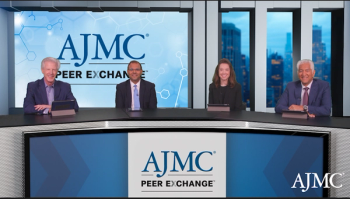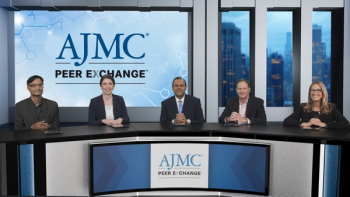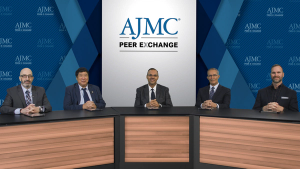
Panelists discuss how reinstating LDL-C targets in quality programs could improve outcomes and accountability.

Nihar Desai, MD, MPH, is a specialist of cardiovascular medicine at the Yale School of Medicine.

Panelists discuss how reinstating LDL-C targets in quality programs could improve outcomes and accountability.

Panelists discuss how substituting LDL outcomes with statin-use metrics weakened cholesterol management quality.

Panelists discuss their excitement about the evolution of heart failure as a distinct specialty with multiple effective therapeutic options, the convergence of previously siloed medical disciplines around shared evidence-based therapies that treat root causes of multiple comorbidities, and emerging technologies like clinical decision support systems and remote patient monitoring to improve population health management and prevent hospitalizations.

Panelists discuss how removing LDL-C targets in 2013 shifted focus from outcomes to statin use, weakening control efforts.

Panelists discuss how social determinants such as access, income, and literacy drive disparities in LDL-C control.

Panelists discuss how payers typically require step therapy with SGLT2 inhibitors before approving nonsteroidal MRAs due to cost considerations, while acknowledging the need for head-to-head trials to determine incremental benefits, though early clinical experience suggests good tolerability and the potential for combination therapy initiation rather than sequential treatment approaches.

Panelists discuss how nonsteroidal MRAs like finerenone differ mechanistically from steroidal MRAs by lacking steroid rings (reducing steroid-related adverse effects like gynecomastia), having different mineralocorticoid receptor binding patterns, shorter half-lives, and potentially lower hyperkalemia risk, with strong evidence supporting their use in heart failure with preserved ejection fraction and additive benefits when combined with SGLT2 inhibitors.

Panelists discuss how real-world programs like PROMPT-LIPID expose undertreatment patterns and guide care improvement.

Panelists discuss how pharmacy-related delays and limited escalation practices widen LDL-C management gaps.

Panelists discuss how mineralocorticoid receptor antagonists (MRAs) remain underutilized despite being foundational therapy for heart failure with reduced ejection fraction due to clinician fears of hyperkalemia and renal dysfunction, while new nonsteroidal MRAs like finerenone show promise across the ejection fraction spectrum with potentially improved adverse effect profiles, though questions remain about their incremental benefit over traditional steroidal MRAs given their substantially higher cost.

Panelists discuss how GLP-1 receptor agonists show promising benefits for patients with HFpEF, particularly those with obesity-related disease, through significant weight loss and improved functional capacity, while their role in HFrEF remains more cautious due to concerns about increased heart rate and potential arrhythmic risks, though observational data suggest additive benefits when combined with SGLT2 inhibitors.

Panelists discuss how: clinical inertia, patient apathy, and the asymptomatic nature of high cholesterol all contribute to undertreatment and poor outcomes.

Panelists discuss how: LDL-C control remains a national crisis, with many patients not on therapy or failing to reach target levels despite the availability of effective treatments.

Panelists discuss how SGLT2 inhibitors evolved from diabetes medications to become foundational heart failure therapy with class I recommendations across the ejection fraction spectrum, providing cardiovascular and renal benefits through unclear but likely multiple mechanisms, with the elegant advantage of single-dose efficacy regardless of diabetes status or heart failure type.

Panelists discuss how ARNIs like sacubitril-valsartan provide superior outcomes compared with ACE inhibitors in HFrEF (20% reduction in cardiovascular events, 16% mortality reduction), with broad FDA approval across the ejection fraction spectrum and recent generic availability improving cost-effectiveness, though ACE inhibitors and ARBs remain viable second-line options when ARNI is not accessible.

Panelists discuss how diuretics serve as necessary “bailout therapy” for volume management in heart failure but should not substitute for guideline-directed medical therapy, with emerging evidence supporting more nuanced approaches to diuresis, including urinalysis monitoring and novel formulations like intranasal furosemide, while noting that effective heart failure therapies actually reduce diuretic requirements.

Panelists discuss how β-blockers remain foundational therapy for heart failure with reduced ejection fraction (using evidence-based agents like carvedilol, metoprolol succinate, or bisoprolol) with proven mortality benefits, while their role in heart failure with preserved ejection fraction is more questionable and potentially overused unless atrial fibrillation is present.

Panelists discuss how guideline-directed medical therapy has evolved to include 4-pillar treatment for heart failure with reduced ejection fraction (angiotensin-converting enzyme inhibitors/angiotensin receptor‐neprilysin inhibitors, β-blockers, mineralocorticoid receptor antagonists, SGLT2 inhibitors) that can reduce mortality by up to 60% and extend life by 6 years, though significant implementation gaps remain, with only about one-third of eligible patients receiving appropriate therapy, necessitating rapid initiation of all 4 drug classes within weeks rather than sequential titration.

Panelists discuss how effective heart failure management requires collaborative care across multiple specialties (primary care, cardiology, endocrinology, nephrology) with advanced practice providers serving as dedicated coordinators, utilizing multidisciplinary teams and algorithm-driven care protocols to optimize patient outcomes and prevent the hot potato approach to complex comorbidities.

Panelists discuss how heart failure classification involves HFrEF vs HFpEF distinctions and staging systems (A through D), with the greatest prevention opportunities existing in early stages A and B, where patients have risk factors or subclinical dysfunction but haven’t yet developed overt clinical symptoms.

Panelists discuss how quality metrics should focus on keeping patients out of hospitals through core medical therapies, measuring all-cause hospitalizations and days spent at home in the community, while tracking both process metrics (guideline-directed medical therapy prescriptions, comorbidity management) and outcome metrics (mortality, readmissions, quality of life) with financial incentives through Medicare Accountable Care Organization programs.

Panelists discuss how heart failure affects 1 in 4 people over their lifetime with 7 million current cases in the US, while Optum Health has implemented an innovative screening program using symptom questionnaires, BNP testing, and echocardiograms for patients over age 60 years during wellness visits.

Panelists discuss how heart failure creates a massive economic burden of approximately $30 billion annually (expected to reach $70 billion to $80 billion by 2030), driven by hospitalizations, readmissions, expensive multidrug regimens costing over $20,000 to $30,000 per patient, and high-cost interventions like ablations and advanced therapies.

Panelists discuss how reaching underserved populations requires proactive outreach, digital health tools with appropriate training, addressing health literacy barriers, and ensuring equitable access to diabetes technologies and treatments rather than waiting for patients to seek care.

Panelists discuss how clinical decision support tools, care pathways, and artificial intelligence can address primary care workforce shortages by providing real-time guidance, predictive modeling for high-risk patients, and autonomous agents for patient outreach and care coordination.

Panelists discuss how data systems and registries should focus on improving care quality rather than just reimbursement, with patient empowerment strategies that encourage individuals to advocate for better treatments like de-prescribing harmful medications.

Panelists discuss how organizations must create system-wide cultural changes through staff training, appropriate clinical environments, evidence-based treatment access, and incentive structures that support rather than punish providers for addressing obesity as a chronic disease.

Panelists discuss how unconscious bias and weight stigma create barriers to care, requiring providers to acknowledge their own biases, create welcoming clinical environments with appropriate accommodations, and approach patients with compassion rather than judgment about willpower.

Panelists discuss how effective provider-patient communication about weight requires opening conversations with empathy and collaboration, using phrases like "I'm concerned about your weight" and avoiding stigmatizing language while understanding patient motivations and readiness for change.

Panelists discuss how supporting primary care providers requires moving beyond passive quality measures to peer-to-peer education, transparent performance feedback, multidisciplinary team resources, and creative care delivery models that address the "27-hour day" problem.

Published: March 31st 2025 | Updated:

Published: October 6th 2025 | Updated:

Published: September 29th 2025 | Updated:

Published: March 31st 2025 | Updated:

Published: October 6th 2025 | Updated:

Published: March 24th 2025 | Updated:

259 Prospect Plains Rd, Bldg H
Cranbury, NJ 08512
© 2025 MJH Life Sciences®
All rights reserved.
